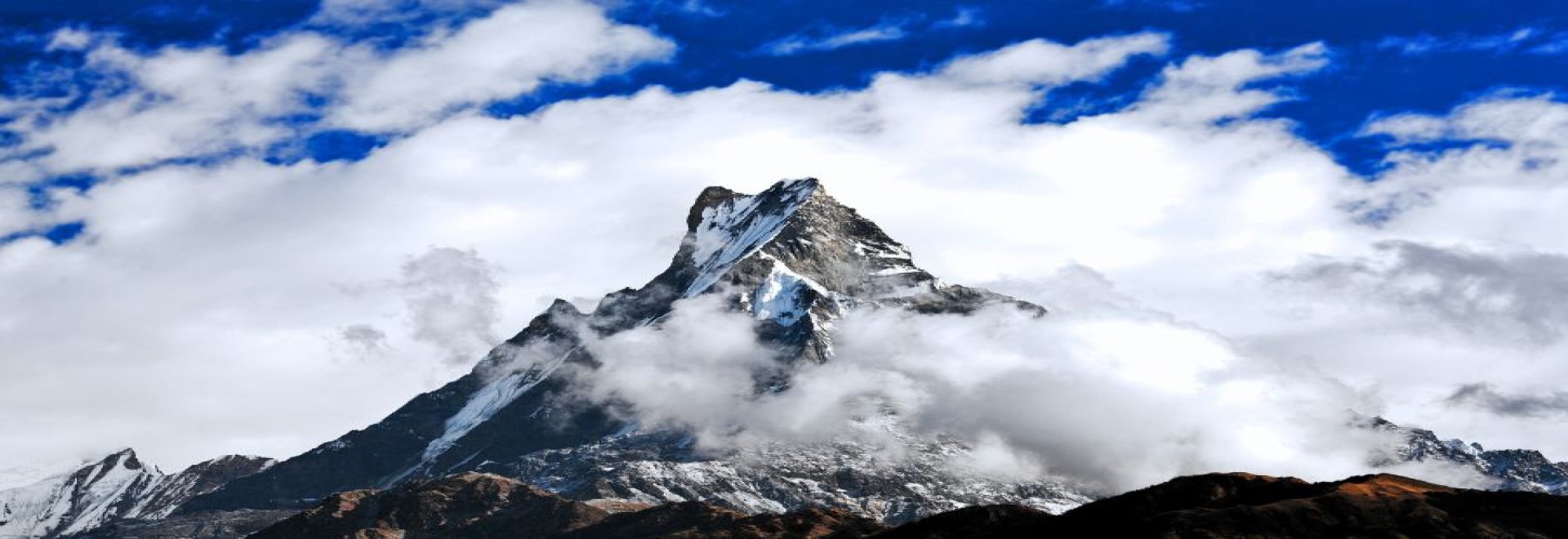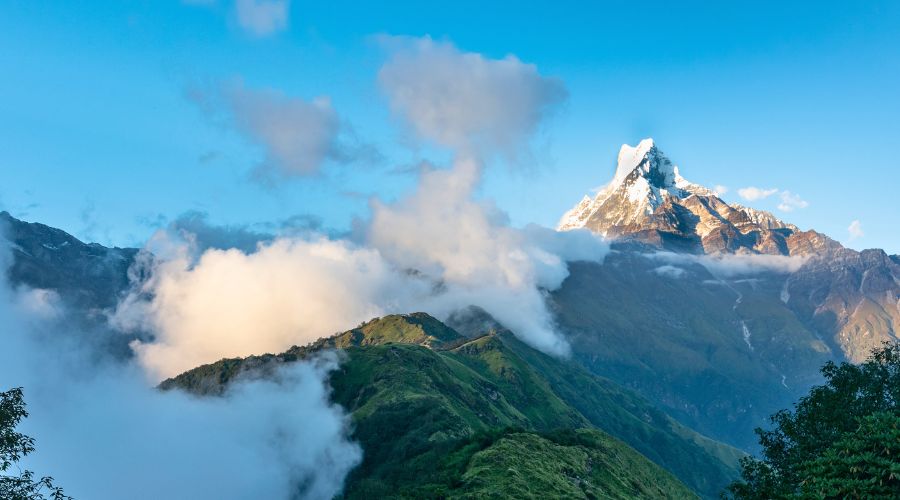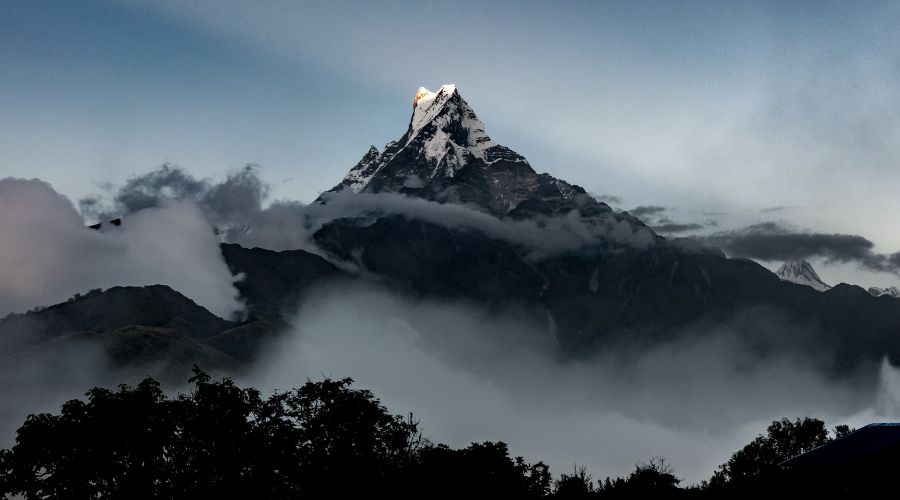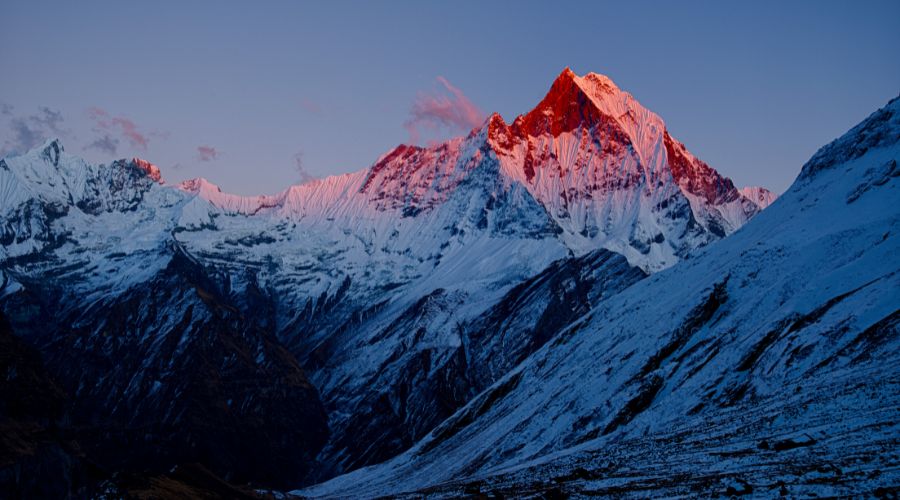
The Mystical Machapuchare: Why Nepal's Holy Mountain Remains Untouched

The Mystical Machapuchare: Why Nepal's Holy Mountain Remains Untouched
swotah travel
18950
20, 11 2023
Machhapuchre/ Fishtail is one of Nepal's most strikingly beautiful mountains, located in the Ganadki region’s Annapurna massif. It is just 26 km/ 16.1557 miles away from Pokhara International Airport by road.
The mountain has twin peaks whose summit looks like a fishtail; that is where the peak gets its name ( translated to Machhapuchre in Nepali).
The striking Mt. Machhapuchre was formed as a result of the Indian tectonic plate and Eurasian landmass collision—the reason why Machhapuchre’s region is said to have fossils of marine species.
It has an altitude of 6993 m / 22943 ft. Machhapuchre is known all over the world for its geographical structure, which is unmatched by any other mountain.
Naturally, mountaineers are keen to be on the summit of this work of art; unfortunately for them, the expedition to the summit was banned by the government of Nepal in 1962 A.D. Since climbing is banned, Mount Machhapuchre is one of the least visited places on the face of the earth. However, this has not stopped people from exploring the area around the Machhapuchre Himal. Trek to the Machhapuchre Base camp is one of the most sought-after treks in Nepal.

Why is the government so firm with the ban, you ask? well, there are a few reasons:
-
Religious significance
-
Protect the Himalayan ecosystem
-
Avoid conflict between climbers and the locals
-
Very dangerous
Although there are four reasons mentioned above, the main reason for forbidding the climbing Machhapuchre is the religious significance. The mystical Machhapuchre holds great religious importance in the local Gurung community residing in the Annapurna region and Hindus.
The mountain is considered one of the homes of the lord Shiva himself, which is why the people around believe it can not be summited. They highly believe that the place should be left holy and untouched by humans. Likewise, local inhabitants of Kaski and Parbat accept Machhapuhre’s two peaks as a representation of the two brothers, Nara and Narayana. Nara and Narayana are the incarnations of God Vishnu, which links another religious sense to Mt.Machhapuchre.
Another religious link of Machhapuchre is the lake formed by the glaciers right below Mt.Machhapuchre along with Mt.Annapurna I and Mt.Annapurna II called Tin Shir (three heads in English). This holy lake used to be one of the most worshipped Hindu pilgrimage sites during a festival called Janai Purnima. As of now, though, the pilgrims do not visit this lake after an avalanche in 2014 A.D. killed many.
The local Gurung people suggest that the ban on climbing the Machhapuchre should be maintained as it has an impact on their religious and cultural reliance and practices, so much so that the Gurung of the southern side of Machhapuchre known the mountain as Katasunkli, a different name altogether. The name Katasunkli translates to snowy fish mouth from the local Gurung language. To this date, Gurung herders have faith in Machapuchre to protect them from possible disasters and are often seen praying and giving offerings to the mountain. They have strong faith in many of their roots and heritages to connect with Mt.Machhapuchre.Even though there is no solid evidence to prove any of the beliefs is right, the government respects the sentiments of people and stands firm with the ban to this date.

Moving on to the next reason, that is protecting the Himalayan ecosystem. With the increase in mountain enthusiasts in past years, the expedition rate has gone up. Economically, the local economy can be benefited, but this can not be favourable for the mountain's ecosystem.
People knowingly or unknowingly have degraded the conditions of mountains while climbing them. Despite all the preaches on responsible trekking, only a few seem to practice what they preach. Keeping this in mind, the government of Nepal is supposed to want to protect the mountain’s natural state and motive to keep it labelled a ‘virgin’ mountain. This point was proven when the Nepal government established the Annapurna Conservation Area in 1992 and protected Mt.Machhapuchre in its territory.
The topic of avoiding conflict between the climbers and the locals arises from the attempted climb to Mt. Machhapuchre in 1957 A.D. The British climbing team led by Jimmy Roberts with two other mountaineers, namely Wilfrid Noyce and A.D.M Cox, did climb the majestic Machhapuchre, but they did not step on the summit itself. The reason for that was, that while handing the climber’s team the permit to climb Machhapuchre the Government (then King) asked them to respect the country’s laws and beliefs and not put their feet on the actual summit/peak. Jimmy Robert’s team climbed Machhapuchre 50 m /164.042 ft below the actual summit and made their way back.
Some do say they only made their way back due to extremely bad weather and technical difficulties and had nothing to do with the king’s request. Whatever the reason, the locals did not seem very pleased with their ascend. This made the government feel there could be possible bitterness and conflict between the locals, climbers, and government in the future if the ban is lifted. It is reported that Jimmy himself also suggested that Mt.Machhapuchre should be inaccessible to the climbers. Rumors have it, the entire ban was requested by Jimmy Robert so as to stop anyone from climbing the mountain he could not summit, which would not be so good for his ego and reputation.
Since Machhapuchre is banned from climbing, you might think, how one could say for sure how dangerous it is?
Well, as mentioned above, Jimmy Robert’s team did return back from 50 m below the summit due to technical difficulties and weather conditions. In addition, the Seti River Valley and Mardi River Valley drain Mt.Machhapuchre, making the climb very risky, especially during the months of monsoon. The southern face of Machhapuchre receives heavy precipitation (rainfall) during the rainy season, increasing the probability of all sorts of mountain hazards.

According to mountain experts, due to the structure of Mt. Machhapuchre, it is prone to more natural disasters despite being 6000er. The climb to the summit to the top (if the ban is ever lifted) is expected to require a lot of technical skills. It has not yet been fully explored there is no research or any information on how climbing the Machhapuchre Himal is at different times of the year, so needless to say, if anyone is ever permitted to climb it they are in to put their life in never known before danger. Therefore, climbing Mt. Machhapuchre is very dangerous from both technical and religious points of view.
Also Read: Dhaulagiri South Face
Has anyone ever climbed to the summit of Machhapuchre/Fishtail?
After 1957 A.D., the government did not give any permits to any climber to attempt climbing Machhapuchre. However, there is always someone who has a knack for breaking the law, like the mountaineer Bill Denz. This New Zealand climber is known for his illegal climbs. Bill Denz is believed to have illegally climbed Machhapuchre through the N ridge NE face route( North East face route) in 1982 A.D. Well, the truth remains unknown as he was killed in 1983 A.D.by an avalanche on his way back from the summit of the world’s fifth tallest mountain- Mt.Makalu (8481 m/ 27825 ft).
Except for Jimmy Robert’s team and Bill Denz, no other climber has ever tried climbing the mysteriously divine Mt. Machhapuchre.

Will the ban ever be lifted from climbing Mt.Machhapuchre?
Municipalities that rely on Tourism have proposed the ban to be lifted for a while now. 2017’s local government passed the village resolution council, which demanded the ban be removed to make the Machhapuchre accessible for climbing. They say there are numerous mountains in Nepal with religious, cultural, and spiritual significance, like Mt.Everest 8848.86 m / 29031 ft 8 ½ inches), Mt.Annapurna (8091 m/ 26545 ft), Mt.Ganesh (7422 m/ 24350 ft), etc. but they are allowed to be climbed.
The latest elected local government in May of 2022 received this proposal. Despite this, the ban is still firm; it seems like nothing is going to change any sooner. We can only sit and wait for the Government to rethink it. Until then, you can enjoy trekking around Machhapuchre and climbing other breathtaking mountains of Nepal. It shelters 1310 of 6000 m plus mountains, and 238 have permission to climb.
Here are things to do around Machhapuchre:
-
Go trekking to the Machhapuchre Base camp. It lies at an altitude of 3700 m/ 12140 ft. This trek offers the best and closest view of Mt. Machhapuchre.
-
Get to know the lifestyle of the local Gurung people living near the Machhapuchre region and know about mystical tales of Machhapuchre Himal.
-
Behold sight of other magnificent snow-capped mountains, namely Mt. Annapurna (8091 m/ 26545 ft), Mt.Gangapurna (7455 m/24459 ft), Mt.Hiunchuli (6441 m/ 21132 ft), etc.
NEWSLETTER SIGNUP
Sign up to receive our trip ideas and travel offers!
Get updates and Exclusive Offers up to 20% Discount








